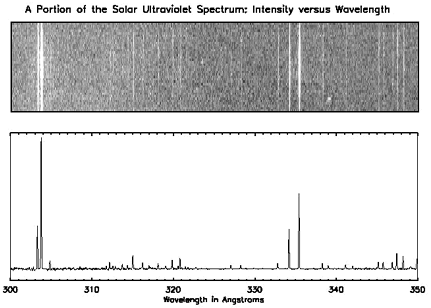Take a Journey of Discovery with RXTE - Classroom Activity

Spectra and Spectroscopy
Spectroscopy is simply the science of measuring and graphing the intensity of light at different energies. Spectra can be made for any energy of light (including UV, optical, and X-ray) - and can in fact, tell us many things about the object being observed.
How do we know what stars are made of?
Spectra of stars or other astronomical objects, can give us information about their composition, for example, what elements are in them. Since particular elements emit light at particular energies or wavelengths, makes us easy to identify their presence. If we look at a spectrum and see a peak or a line occuring at an energy or wavelength we associate with a particular element, we can identify it and even know how abundant that element in that particular star.
In the below spectra of the Sun, you will see the spectrum of the Sun at ultraviolet wavelengths. There are distinct lines (in the top graph) and peaks (in the bottom one) and if you look at the X-axis, you can see what energies they correspond to. For example, we know that helium emits light at a wavelength of 304 Angstroms, so if we see a peak at that wavelength, we know that there is helium present.

How can we tell if a star is moving?
If the peaks in the spectrum are shifted from where we expect to see them, or broadened, this tells us that the photons of light that we are detecting are in motion. If a photon is emitted by an atom in motion, the wavelength of the detected photon is changed by something called the Doppler effect. For example, if an atom be moving away from our detector while it's emitting a photon, that photon's wavelength appears to be longer than we expect. This is called a redshift.
Similarly, if the atom is moving towards us, it's light is received at a shorter wavelength, or is blueshifted. It is using this method of looking at Doppler shifted spectral lines that we can detect the motion of a star or in the case of X-ray spectra even "see" orbiting disks of matter called accretion disks.
X-ray spectra are an important part of X-ray astronomy. X-ray light contains a range of energies within it, just like visible light, with its range from reds to blues. RXTE has spectrometers on it that counts the number of photons of differing energies hitting it. A graph of the number of X-ray photons over an energy range can tell us how the source is producing its X-rays, which can give us clues as to what kind of object it is!


